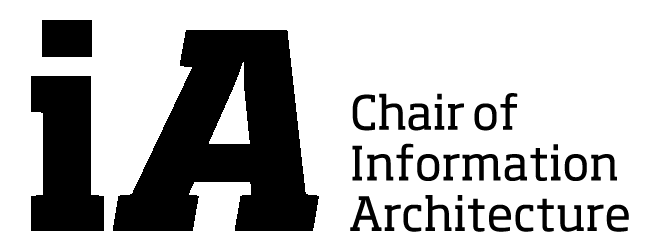This lecture discusses ideas associated with the phrase ‘Information Architecture’ and relates to them in meaningful ways as to how information can be gathered, organized and presented, and we will discuss the inter-relationship between information and architecture.
L02 | 23-02-2009
EXCURSION
An excursion to the Biblioteca Werner Oechslin in Einsiedeln provides a historical and future view on Information Architecture. Prof Dr Werner Oechslin and Prof Dr Gerhard Schmitt takes you on a journey starting in Alexandria…
L03 | 02-03-2009
HISTORY OF INFORMATION ARCHITECTURE
The lecture provides a current and future view on the Architecture of Information. We will take you on a journey starting with card boxes and leading to hypertext and ‘Web 3.0’. You will learn about space, structure and interface as three different properties of Information Architecture.
L04 | 09-03-2009
THINKING INFORMATION AS RAW MATERIAL
You will get an overview on the difference between the research fields Information Design, Information Visualization and Knowledge Visualization. You will experience visual perception phenomena and develop an understanding on how our visual channel works.
L05 | 16-03-2009
INFORMATION. THE 5TH DIMENSION IN ARCHITECTURE
In the future, buildings will talk to one another. In the era of ubiquitous computing—as sensors disappear into the woodwork and all kinds of data is transferred instantly and wirelessly—buildings will communicate information about their local conditions to a network of other buildings. Architecture will come to life.
L06 | 30-03-2009 | HIT Building, Room F22
Push.Click.Touch.
Visiting the Value Lab
People have developed sophisticated skills for sensing and manipula-ting our physical environments. However, most of these skills are not employed by traditional GUI (Graphical User Interface). Tangible Bits seeks to build upon these skills by giving physical form to digital information, seamlessly coupling the dual worlds of bits and atoms.
L07 | 06-04-2009
SMART ENVIRONMENTS
As collaborative environments evolve beyond the desktop, you see the emergence of a new class of augmented collaborative spaces that employ various devices and technologies to merge electronic information with physical space to support collaboration, both local and remote. This demands richer ways of capturing content and actions, new ways of presenting multimodal information, and developing an architecture and infrastructure that unifies individuals, spaces, and processes to facilitate collaboration.
L08 | 27-04-2009
Spatial Applications – The Relationship between Spaces and Places
This background serves to inspire new design perspectives that appreciate traditional approaches but attempt to address human understanding and user behavior. Untraditional approaches are also considered, including recent explorations into more human commonsensical understanding of space, the relationship between spaces and places, and the tension between the need for social sharing of spatial information.
L09 | 04-05-2009
NEW METHODS IN URBAN SIMULATION
Modeling a city poses a number of problems to computer graphics. Every urban area has a transportation network that follows population and environmental influences, and often a superimposed pattern plan. The buildings appearances follow historical, aesthetic and statutory rules. To create a virtual city, a roadmap has to be designed and a large number of buildings need to be generated. We propose a system using a procedural approach based on L-systems to model cities – the CityEngine.
L10 | 11-05-2009
FROM MAPPING TO REALITY
Guestlecturer Markus Schaefer
Markus Schaefer will show recent work of Hosoya Schaefer Architects illustrating their current thinking on urban planning and design. Two projects will be shown in more detail – Mobiglobe, a research and media project for Volkswagen and Smartinska Partnership, a 230 ha masterplan in Ljubljana, Slovenia.
HOSOYA SCHAEFER is a Zürich based studio for architectural designs, strategies and research. With an international network of collaborators, the studio is involved in building design and realization, media installations, urban planning and consulting.
http://www.hosoyaschaefer.com
L11 | 18-05-2009
REALIZING COMPLEXITY IN ARCHITECTURE
Guestlecturer Fabina Scheurer
designtoproduction is an ETH spin-off and was founded in 2006. It supports architects, planners, engineers, and contractors in the efficient design and production of non-standard architecture…
Digital technology has widely expanded the solution space for architectural design. Powerful software tools allow the exploration of non-standard forms with intuitive user interfaces and hide the complexities of blobs, twists and folds during design. But when it comes to the precise realization of those shapes, the complexity is back…
http://www.designtoproduction.ch/


